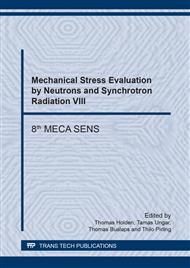[1]
E.T. Stewart-Jones, Forgings in Aluminium and Magnesium, in: Proc. Conference on Heat Treatment of Engineering Components, Iron and Steel Institute, London, 1969, pp.83-101.
Google Scholar
[2]
R. Becker, M.E. Karabin, J.C. Liu, R.E. Smelser, Distortion and residual stress in quenched aluminum bars, Journal of Applied Mechanics-Transactions of the Asme, 63 (1996) 699-705.
DOI: 10.1115/1.2823352
Google Scholar
[3]
P.J. Withers, H. Bhadeshia, Overview - Residual stress part 2 - Nature and origins, Mater. Sci. Technol., 17 (2001) 366-375.
Google Scholar
[4]
M.B. Prime, M.R. Hill, Residual stress, stress relief, and inhomogeneity in aluminum plate, Scr. Mater., 46 (2002) 77-82.
DOI: 10.1016/s1359-6462(01)01201-5
Google Scholar
[5]
R.T. Myer, S.A. Kilpatrick, W.E. Backus, Stress-Relief of Aluminium for Aircraft, Metal Progress, 3 (1959) 112-115.
Google Scholar
[6]
R.E. Kleint, F.G. Janney, Stress Relief in Aluminum Forgings, Light Metal Age, 2 (1958) 14-21.
Google Scholar
[7]
W. Betteridge, The relief of internal stresses in Aluminum alloys by cold working, in: Symposium on internal stresses in metals and alloys, Institute of Metals, London, 1948, pp.171-177.
Google Scholar
[8]
Y. Altschuler, T. Kaatz, B. Cina, Mechanical Relaxation of Residual Stresses, in: ASTM STP 993, 1988, pp.19-29.
Google Scholar
[9]
B.D. Cullity, S.R. Stock, Elements of x-ray diffraction, 3d ed., Prentice Hall., Upper Saddle River, New Jersey, USA, (2001).
Google Scholar
[10]
S.J. Lewis, C.E. Truman, Diffraction measurements for evaluating plastic strain in A533B ferritic steel-a feasibility study, J. Phys. D-Appl. Phys., 43 (2010).
DOI: 10.1088/0022-3727/43/26/265501
Google Scholar
[11]
G.E. Dieter, Hot compression testing, in: G.E. Dieter (Ed. ) Handbook of Workability and Process Design, ASM International, 2003, pp.64-67.
Google Scholar
[12]
A.D. Krawitz, Neutron strain measurement, Mater. Sci. Technol., 27 (2011) 589-603.
Google Scholar
[13]
IS0/TTA3, Polycrystalline materials – Determination of residual stresses by neutron diffraction, in: Technology trends assessment, International standardisation organisation, (2001).
Google Scholar
[14]
D.C.I.T. 21432, Non-destructive testing. Standard test method for determining of residual stresses by neutron diffraction, in, British Standards Institute, (2005).
DOI: 10.3403/30372102u
Google Scholar
[15]
M.T. Hutchings, P.J. Withers, T.M. Holden, T. Lorentzen, Introduction to the characterisation of residual stress by neutron diffraction, CRC Press, Boca Raton, FL, USA, (2005).
DOI: 10.1201/9780203402818
Google Scholar
[16]
P.J. Withers, H. Bhadeshia, Overview - Residual stress part 1 - Measurement techniques, Mater. Sci. Technol., 17 (2001) 355-365.
Google Scholar
[17]
M.E. Fitzpatrick, A.T. Fry, P. Holdway, F.A. Kandil, J. Shackleton, L. Suominen, Determination of residual stresses by X-ray diffraction, in, NPL, (2002).
Google Scholar
[18]
N. Chobaut, J. Repper, T. Pirling, D. Carron, J. -M. Drezet, Residual Stress Analysis in AA7449 As-Quenched Thick Plates Using Neutrons and FE Modelling, in: ICAA13: 13th International Conference on Aluminum Alloys, John Wiley & Sons, Inc., 2012, pp.285-291.
DOI: 10.1002/9781118495292.ch44
Google Scholar
[19]
H. Zhang, X. Liang, D.F. Fu, G.Y. Lin, D.S. Peng, Influence of quenchant factors on residual stresses in quenched 7075 aluminium-alloy thick plate, Heat Treat. Met., 30 (2003) 61-64.
Google Scholar
[20]
J.S. Robinson, D.A. Tanner, S. van Petegem, A. Evans, Influence of quenching and aging on residual stress in Al-Zn-Mg-Cu alloy 7449, Mater. Sci. Technol., 28 (2012) 420-430.
DOI: 10.1179/1743284711y.0000000063
Google Scholar
[21]
J.S. Robinson, P.J. Tiernan, J.F. Kelleher, Effect of post-quench delay on stress relieving by cold compression for the aluminium alloy 7050, Mater. Sci. Technol., 31 (2015) 409-417.
DOI: 10.1179/1743284714y.0000000571
Google Scholar
[22]
K. Zhan, X.Y. Wu, C.H. Jiang, V. Ji, Thermal Relaxation Behavior of Residual Stress and Microstructure in Shot Peened S30432 Steel at Elevated Temperatures, Materials Transactions, 53 (2012) 1195-1198.
DOI: 10.2320/matertrans.m2012058
Google Scholar


